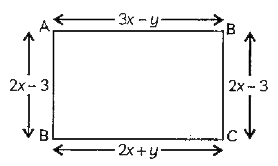The perimeter of a rectangle is 72 cm. If the sides are positive integers, maximum how many distinct areas can it have?
18
9
36
35
The correct Answer is:A
To solve the problem, we need to determine the maximum number of distinct areas that a rectangle can have given that its perimeter is 72 cm and its sides are positive integers.
1. Understanding the Perimeter Formula:
The perimeter P of a rectangle is given by the formula:
P=2(l+w)
where l is the length and w is the width of the rectangle.
2. Setting Up the Equation:
Given that the perimeter is 72 cm, we can set up the equation:
2(l+w)=72
Dividing both sides by 2 gives:
l+w=36
3. Finding Possible Integer Pairs:
Since l and w are positive integers, we can express w in terms of l:
w=36−l
To ensure both l and w are positive integers, l must satisfy:
1≤l<36
4. Calculating Areas:
The area A of the rectangle is given by:
A=l×w=l×(36−l)=36l−l2
This is a quadratic function in terms of l.
5. Finding Distinct Areas:
We need to find the distinct values of A for integer values of l from 1 to 35. The expression A=36l−l2 is a downward-opening parabola, which means it will have a maximum area at its vertex.
6. Finding the Vertex:
The vertex of the quadratic A=−l2+36l occurs at:
l=−b2a=−362×−1=18
At l=18:
w=36−18=18
So, the maximum area is:
A=18×18=324 cm2
7. Calculating Distinct Areas:
As l varies from 1 to 35, the areas will be:
- For l=1, A=1×35=35
- For l=2, A=2×34=68
- For l=3, A=3×33=99
- ...
- For l=17, A=17×19=323
- For l=18, A=18×18=324
- For l=19, A=19×17=323
- ...
- For l=35, A=35×1=35
The areas will start repeating after l=18.
8. Counting Distinct Areas:
The distinct areas can be calculated by evaluating the areas for l from 1 to 18, which gives us:
A=35,68,99,128,155,180,203,224,243,260,275,288,299,308,315,320,323,324
This results in 18 distinct areas.
Conclusion:
The maximum number of distinct areas that the rectangle can have is 18.
The perimeter P of a rectangle is given by the formula:
P=2(l+w)
where l is the length and w is the width of the rectangle.
Given that the perimeter is 72 cm, we can set up the equation:
2(l+w)=72
Dividing both sides by 2 gives:
l+w=36
Since l and w are positive integers, we can express w in terms of l:
w=36−l
To ensure both l and w are positive integers, l must satisfy:
1≤l<36
The area A of the rectangle is given by:
A=l×w=l×(36−l)=36l−l2
This is a quadratic function in terms of l.
We need to find the distinct values of A for integer values of l from 1 to 35. The expression A=36l−l2 is a downward-opening parabola, which means it will have a maximum area at its vertex.
The vertex of the quadratic A=−l2+36l occurs at:
l=−b2a=−362×−1=18
At l=18:
w=36−18=18
So, the maximum area is:
A=18×18=324 cm2
As l varies from 1 to 35, the areas will be:
- For l=1, A=1×35=35
- For l=2, A=2×34=68
- For l=3, A=3×33=99
- ...
- For l=17, A=17×19=323
- For l=18, A=18×18=324
- For l=19, A=19×17=323
- ...
- For l=35, A=35×1=35
The distinct areas can be calculated by evaluating the areas for l from 1 to 18, which gives us:
A=35,68,99,128,155,180,203,224,243,260,275,288,299,308,315,320,323,324
This results in 18 distinct areas.
The maximum number of distinct areas that the rectangle can have is 18.
Topper's Solved these Questions
Similar Questions
Knowledge Check
The perimeter of a rectangle is 72 cm. If the sides are positive integers, maximum how many distinct areas can it have?
A12B8C9D6The perimeter of a triangle is 10 cm. If one of the side is 4 cm, then for its maximum area, remaining two sides are
A3 cm, 3 cmB2 cm, 4 cmC5 cm, 1 cmD3.5 cm, 2.5 cmIf the perimeter of a semicircle is 72 cm, then find its area (in cm2 ).
A308B616C160D320
If the perimeter of a rectangle is 10 cm and the area is 4cm2, then its length is
View Solutionperimeter of a rectangle is 40, find the maximum possible area of the rectangle.
View SolutionThe perimeter of a rectangle is 72 meters and its area is 315 square meters. Find the length of the rectangle
View SolutionThe perimeter of a rectangle is 130 cm. If the breadth of the rectangle is30 cm, find its length. Also find the area of the rectangle.
View Solution
Given that the perimeter of the rectangle is 120cm, find:
the area of the rectangle.
View Solution